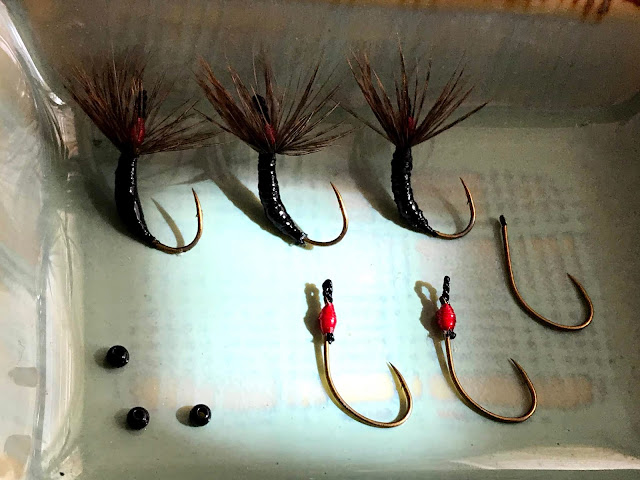My "go to" kebari is a pattern that I have settled on and have been tweaking to use at all depths. It is the "Wrong Kebari" and I've named it that way as a twist on words. If you click on the link, you will see why I name it that. But this is a variation on the theme, I use tungsten beads because of the limited reach of a tenkara rod. I want to preface "limited reach" because I use relatively long lines compared to everyone I have fished with. For a 3.9m rod, I'll use a 5-6m mainline plus about a 50cm of tippet. Most people I have fished with use a line as long as their rod which I find much too short to reach and play big fish. All of this into account, I want the fly/kebari to sink NOW and I want the hook point to ride up as I am swimming or playing the fly.
Integrating tungsten beads, I tye in the silk bead cord on the underside of the hook to keep the end flare from turning the hook to it's side. Eiji Yamakawa tyes his hooks like this and by the way. I do not overwrap, it does not take much to hold the silk bead cord on to the hook. It only has to be stronger than the strongest tippet I use. I have never broken or had a silk loop let go. Tye them in tight and straighten out the loop with your whip finisher. You can also strength check your loops like I do with the whip finisher. I give all my loops a couple of good tugs to simulate a fish fight. Tying in the loops is a little bit of extra time but the hooks are so sharp and I love the shape. You can check out why I use bait hooks in the article about the "Wrong Kebari."
I also use "Owner Super Yamame" bait hook that are available from Tenkarabum or Tenkara Ya. I use this hook on the suggestion of Yamakawa-san. It is super sticky sharp and has a slight barb that I am still able to back out without forceps if I do not have them.
The above Wrong Kebari have 2mm tungsten beads tyed in the black body. The bodies are coated with "Sallys Hard as Nails" clear nail polish. I find that this helps keep the thread from wearing and or the bead from chipping. I think it may help, maybe not. I do know I catch a lot of fish on this version. On a lot of trips, my friends end up using this one a lot. I always tye a few because I end up handing them out. I really enjoy it when people catch fish on flys that I have tyed, quite an honor.
You can use different sizes of tungsten beads depending on what you want to do with your kebari. These are size 7/64, I do not go much heavier than this, these sink RIGHT NOW and they lose action when they are heavier than this.
I use BLACK beads to match the Uni thread that I tye with. I do not wrap thread over the beads, I tye off and then tye back in and taper the body.
I have caught fish 10' deep in good flow with my 3.9m rod and a 5m line. That is casting straight upstream and letting the kebari drop into the deep pool with the flow. Catching fish this deep is a skill that I like to hone. I learned this using heavy gauge hooks. Often I knew there were fish but I was not catching them. I started to use typical brass beads with the bead in the placement behind the eye but the way I was observing the fly, I did not like the way it swam and rode over rocks. So I started tying in the bead a little bit farther back until I found the sweet spot.
You may like to try this sometime. If you do not like Japanese bait hooks or do not have them, you can use a "jig hook" to keep the point up. Or, you can use a slotted tungsten bead on a jig hook if you are a fly fisherman and follow those lines of fly tying.
What ever way you want to do it, tungsten beads help get your fly down NOW so that they are in the fish catching zone much longer with our limited tenkara rods and line lengths.










Is there an advantage to using the bead cord? What knot do you use to connect to the tippet?
ReplyDeleteI use a simple 6 twist clinch knot. Silk bead cord is simply a traditional choice. It is strong, pliable and easy to work with.
ReplyDelete